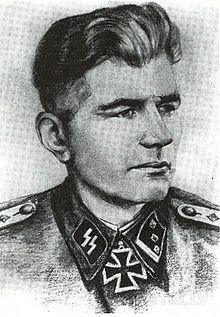- Miervaldis Adamsons
-
Miervaldis Adamsons 
Portrait of Miervaldis ĀdamsonsNickname The Moroccan Terror Born June 29, 1910
Poltava, Russian Empire
Now UkraineDied August 23, 1946 (aged 36)
Riga, Latvian SSR
Now LatviaAllegiance  France
France
 Latvia
Latvia
 Nazi Germany
Nazi GermanyService/branch  Waffen SS
Waffen SSYears of service 1929 — 1936
1936 — 1939
1942 — 1945Rank Hauptsturmführer Unit - 8th Daugavpils Infantry Regiment
- 26th Tukums Police Battalion
- 19th Waffen Grenadier Division of the SS (2nd Latvian)
Commands held 6th Company, 44th Waffen Grenadier Regiment Battles/wars World War II Awards - Knight's Cross of the Iron Cross
- Iron Cross I Class
- Iron Cross II Class
- German Cross in Gold
- Close Combat Clasp in Bronze
- Infantry Assault Badge in Silver
Wound Badge in Gold [1]
Miervaldis Adamsons (Latvian: Miervaldis Ādamsons) was a Hauptsturmführer in the Waffen SS during World War II. Who was awarded the Knight's Cross of the Iron Cross, which was awarded to recognize extreme battlefield bravery or successful military leadership by Nazi Germany during World War II.
Contents
Early life
Miervaldis Adamsons was born on the 29 June 1910, in Poltava. In the 1920s his family returned to Latvia where in 1928, Miervaldis started theology studies at the University of Latvia. In this period he became a member of the oldest Latvian student fraternity, Lettonia. He left his studies and joined the Merchant navy. During his travels he landed in France and joined the French Foreign Legion and served in operations in Morocco, where he earned the nickname The Moroccan Terror and was promoted to be an NCO.[1][2]
After his service in the Foreign Legion he returned to Latvia and joined the Latvian Army serving as an officer in the 8th Daugavpils Infantry Regiment.[2]
World War II
The Latvian Army was disbanded under the occupation of the Soviet Union so when the Germans invaded in Operation Barbarossa in June 1941, Adamson voluntarily joined the 26th Tukums Battalion and by June 1942 was stationed in the Minsk region on anti Partisan duties. In April 1943, Adamson was now in the 2nd Battalion, Latvian Brigade on the Leningrad front and took part in the Battle of Wolchow where he was severely wounded in the head and eye. He was also awarded the Iron Cross for bravery.[1][2]
After recovering from his wounds he was given command of the 6th Company, 44th Waffen Grenadier Regiment, 19th Waffen Grenadier Division of the SS (2nd Latvian) which had been formed from the Latvian Brigade. He was again wounded in August 1944 just before being promoted to Hauptsturmführer in September 1944.[1][2]
Returning to the front he was involved in the battle of the Kurland Pocket in December 1944 and was again seriously wounded and partly lost his eyesight. His company in a single 24-hour period repelled seven attacks by the Russians, and after the battle the bodies of 400 fallen Russian soldiers could be counted in front of the Latvians positions.[3] So fierce was the fighting the Russian 100th Army Corps was completely destroyed.[2]
For this remarkable defensive success Adamsons was awarded the Knights Cross in January 1945. Spring of the 1945 he spend in various military hospitals in Courland.
Post war
Adamsons survived the war and while in Hospital he entered Soviet captivity in May 1945. He was sent to work in the nickel mines at Murmansk and tries to escape to Finland in winter 1945/46. He was recaptured near the Finnish border. After that he was sentenced to death for treason.[2]
Miervaldis Adamsons was executed in Riga on the 23 August 1946 by firing squad.[1][2] In 1993 Ādamosns was fully exonerated by Latvian supreme court.
Miscellaneous
The Latvian Legion's attachment to the SS, unit designations and ranks were considered a formality. Latvian and Estonian soldiers regardless of whether they volunteered or were drafted, were not members of the Nazi party.
In 1949-50, United States Displaced Persons Commission investigated the Estonian and Latvian "SS" and found these military units to be neither criminal nor Nazi collaborators. On 12 September 1950, Harry N. Rosenfield, the United Nations Refugee Relief Association commissioner, wrote to Jūlijs Feldmanis, Latvia's chargé d'affaires in Washington, saying that «the Waffen-SS units of the Baltic States (the Baltic Legions) are to be seen as units that stood apart and were different from the German SS in terms of goals, ideologies, operations and constitution, and the Commission does not, therefore, consider them to be a movement that is hostile to the government of the United States under Section 13 of the Displaced Persons Act, as amended.»
References
Further reading
- Henschler, Henri. & Fay, Will. (2003). Armor Battles of the Waffen-SS 1943-45. Stackpole Books. ISBN-10: 0-8117-2905-2
- Fellgiebel, Walther-Peer. (2000). Die Träger des Ritterkreuzes des Eisernen Kreuzes 1939-1945. Friedburg, Germany: Podzun-Pallas. ISBN-10: 3-7909-0284-5
- Mitcham Jr., Samuel. (2007). Retreat to the Reich. Stackpole Books. ISBN-10: 0-8117-3384-X
- Mitcham, Samuel. (2007). The German Defeat in the East, 1944-45. Stackpole Books. ISBN-10: 0-8117-3371-8
Categories:- 20th-century Latvian people
- SS officers
- Recipients of the Knight's Cross
- Recipients of the German Cross
- Recipients of the Close Combat Clasp
- University of Latvia alumni
- People executed by the Soviet Union
- Latvian expatriates in Ukraine
- Latvian expatriates in Russia
- Latvian expatriates in Germany
- People from Poltava
- 1910 births
- 1948 deaths
Wikimedia Foundation. 2010.
